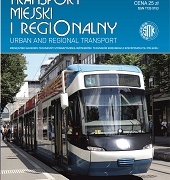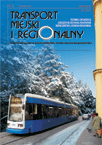Abstract 6/2017
Table of content
Katarzyna Czekała, Zofia Bryniarska – The empty methodfor assessment of selected interchanges in Krakow’s public transport
Aleksandra Ciastoń-Ciulkin – Analysis of travel comfort level in aglomeration trains on the route: Krakow Airport /Wieliczka Mine Market
Andrzej Massel – Evolution of the state of railway infrastructure in the Łódź voivodeship
Pająk Marcin, Soczówka Andrzej – Synchronization of tram lines on the example of the Dąbrowski Basin
Abstracts
Katarzyna Czekała, Zofia Bryniarska
The empty methodfor assessment of selected interchanges in Krakow’s public transport
Abstract: Interchanges within urban public transport system are important elements in increasing the accessibility and availability of public transport. Numerous European projects attempt to determine the conditions that interchanges should meet in order to facilitate for passengers changing means of public transport. Well planned and executed infrastructure solutions within interchange areas may allow passengers to shorten the duration of their journey (reduce waiting time of direct connections), reduce physical strain and increase uncertainty or confusion when changing modes of transport. The AMPTI method for assessment of public transport interchanges have been used in the article to evaluate three important interchanges in Krakow: Rondo Mogilskie, Dworzec Główny and Borek Fałęcki. The advantage of this method, on the one hand, rely on the comprehensive analysis of many aspects of accessibility of the interchange for passenger: beginning from the distance to walk between the tram/bus stops, through the quality of execution and maintenance of the tram/bus stop and the quality of infrastructure elements, the availability and comprehensiveness of passenger information, level of personal safety and safety of traffic and ending at additional elements of stops’ equipment and, on the other, the quantitative dimension of these indicators. As a result the AMPTI indicators can be used to evaluate existing and planned interchanges. Moreover, the results of marketing survey on the overall quality of the transfer and level of passenger information within these interchanges have been presented.
Key words: tram transport, traffic flow, public transport
Aleksandra Ciastoń-Ciulkin
Analysis of travel comfort level in aglomeration trains on the route: Krakow Airport / Wieliczka Mine Market
Abstract: The article presents an analysis of the comfort level of trains operating on the connection Krakow / Krakow Airport Railway. This analysis was based on the occupancy rate of the vehicle and the nuisance coefficient of driving, which determines how many times the train travel is more burdensome than the unrestricted journey in low fill conditions (0,5 person/m2). The analysis includes all courses performed on the route during the working day in both directions. For each factor size, an appropriate assessment of travel comfort was provided for each course and for each section of the route.
Key words: agglomeration rail, public transport, travel comfort, quality criteria
Andrzej Massel
Evolution of the state of railway infrastructure in the Łódź voivodeship
Abstract: This article refers to changes in the state of railway infrastructure in the Łódź voivodship in the years 1990-2015. The state of railway infrastructure is an essential factor influencing the quality of services provided by passenger and freight carriers. From the operational and commercial point of view, the assessment criteria that bind the condition of the infrastructure to the conditions of its use are of utmost importance. Out of these indicators, groups of criteria related to maximum speeds, speed limits and acceptable axle load have been considered as the most important. The article presents the evolution of these indicators in the analyzed period. Particular indicators prove that since 1990 the railway infrastructure in the Łódź voivodeship has been systematically degrading. The most noticeable has been the reduction of maximum speeds and the increasing number of fixed speed limits on many important sections of the line. The visible improvement has been caused by modernization and revitalization investments, both linear and point-of-sale (in particular crossings and level crossings), as well as an increase in repair and maintenance works. Practical exploitation effect of the infrastructure’s condition is the passage time achieved on particular sections of the network. The evolution of these times has been presented for major regional links.
Key words: railway infrastructure, regional transport, Łódź voivodeship
Pająk Marcin, Soczówka Andrzej
Synchronization of tram lines on the example of the Dąbrowski Basin
Abstract: The problem of synchronization of the tram line is discussed on the example of the Dąbrowski Basin, the eastern part of the network connecting 13 cities of the Katowice conurbation. On this part of the network lines run with different frequency modules, which prevents good coordination. An additional barrier is the one-lane ramp sections with turnouts. The article contains a simplified methodology for evaluating the possibilities and costs of rerouting of tram networks. The basic principles of line synchronization are described here. Based on the presented methodology, a new synchronization project has been prepared – the answer to the question: is this 15- and 20-minute module better for this part of the network, or are there technical and financial possibilities of introduction of 10-minute modules in peak hours? Taking into account the infrastructure barriers, both options analyzed the level and quality of the offer on major transport routes, the amount of weekly operating work, demand for rolling stock, working time of the managers and estimated costs of reform by administrative units. The tables for line coordination in 10-, 15-, and 20-minute modules are also presented. The research has shown that the introduction of uniform passenger-friendly frequencies in the Dąbrowski Basin is not possible without additional infrastructure investments.
Key words: public transport,tram transport, synchronization


 SITK RP
SITK RP  SITK RP
SITK RP  SITK
SITK  SITK RP
SITK RP  SITK RP
SITK RP 

